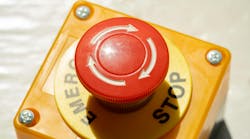A Control Design reader writes: What are the acceptable forms of an e-stop button? We typically see the mushroom-head push button, but are other manual actuators acceptable under the appropriate standards? What about color—red and yellow? Are remote or touchscreen e-stops feasible and compliant?
Answers
Work with operators
Emergency stop (e-stop) buttons are significant safety devices used as part of the human-machine interface (HMI) to quickly shut down equipment in emergency situations. The acceptable forms can vary depending on the specific standards and regulations applicable to the industry or location, so it is critical to review American National Standards Institute (ANSI)/ Robotics Industries Association (RIA) R15.06, International Organization for Standardization (ISO) 13850, to ensure compliance with applicable requirements and alignment with best practices.
It’s equally important to work with the operators who will be interfacing with the equipment to understand access points and types of actuators that will provide quick and efficient use in emergency situations.
From my experience, there are some general principles and common practices:
- The mushroom-head push button is the most common form of e-stop button. They are easily identifiable and can be operated quickly in an emergency.
- Other manual actuators may include pull switches or other types of push buttons with distinctive shapes or features that make them suitable for emergency-stop applications.
- Red is the most widely accepted color for e-stop buttons because it is highly visible and universally recognized as a signal for stopping or indicating an emergency. Red means stop; yellow means caution. In the event of an emergency, we want to stop the equipment, not take caution or slow it down.
- Touchscreen e-stops may be technically feasible, but their compliance with safety standards may vary depending on factors such as reliability, visibility and ease of operation. Prior to implementing, failure rates and false activations must be considered, as well as ensuring that operators can quickly and easily access the emergency-stop function when needed.
- Routine testing of any type of e-stop must be conducted to ensure functionality. It’s important to consider the type of e-stop you are using to determine the frequency of testing.
- Similar to personal protective equipment (PPE), e-stops are the last line of defense to prevent an injury. Other safeguards and controls, such as guarding and light curtains, must work in conjunction with the e-stop to provide safe and reliable equipment function.
- It’s crucial to consider the specific application, environment and operational requirements to choose the most suitable type of e-stop button for the situation. It’s not a one-size-fits-all approach.
Rebecca Stephenson, director of risk / Gray Solutions
Red signals stop
According to ISO 13850:2015 and ANSI B11.19-2019, emergency-stop devices (e-stops) are used to reduce risk, but they do not serve as a substitute for safeguarding measures. As stated in ANSI B11.19, “Since an individual must manually actuate an emergency-stop device to initiate the stop command, usually in reaction to an event or hazardous situation, it neither detects nor prevents exposure to a hazard.” E-stops are intended to avert arising or existing hazards to persons or damage to machinery or work in progress.
Emergency-stop devices shall be designed to be easily identified and actuated by a single human action.
However, identification of the actuator or the background cannot be labelled with text or symbols. The actuator of the e-stop device shall be colored red, and, if a background exists behind the actuator, the background shall be colored yellow when possible.
An emergency-stop device may exist in one of several forms, according to ANSI B11.19-2019, CSA Z432:23 and National Fire Protection Association (NFPA) 79-2024:
- Pushbutton-operated devices or mushroom-head type that are easily activated by the palm of a hand. Actuator/button must be red and the background must be yellow.
- Rope or cable pull-operated devices where the actuator is not run through conduit or other tubing, and the device will detect a slack condition or a break of the rope or cable. Actuator/cable must be red; if flags or markers are used along the rope, they must be red and yellow.
- Foot-operated devices without a protective cover, are applicable where other solutions are not. Actuator/pedal must be red; background should be yellow where feasible. These devices should be mounted in a fixed position directly at access level.
- Rod-operated devices are designed to be actuated by the hand of an individual. Actuator/rod must be red; background should be yellow where feasible.
- Push-bar-operated devices are designed to be actuated by the body of an individual. Actuator/bar must be red; background should be yellow where feasible.
E-stops shall be in the following areas:
- at each operator control station, unless a risk assessment deems this not necessary
- at other locations such as entrance and exit locations, as determined by the risk assessment
- at locations where intervention to the machinery is expected—loading/unloading.
An interface on a touchscreen or human-machine interface (HMI) is not permitted to be used as an e-stop device. International Electrical Commission (IEC) 60947-5-1 states e-stops require a direct opening action of an electrical contact. This cannot be provided through a touchscreen. In addition, an e-stop must always be accessible and active during all modes of operation, and a touchscreen interface cannot fulfill this requirement if it loses power or is reprogrammed.
When considering implementation of wireless e-stops, several aspects must be considered within IEC 60204-1:2016. The cableless control system (CCS) shall have functionality and response time suitable for the application based on the risk assessment.
The CCS shall be designed as follows:
- It shall be automatically monitored, either continuously or at suitable intervals and the status of this ability shall be clearly indicated—through an indication light/visual display indication.
- If the communication signal is degraded, a warning to the operator shall be provided before the ability of the CCS to control a machine is lost.
- An automatic stop of the machine shall be initiated when the ability of the CCS to a machine is lost for a time interval determined by the risk assessment.
- Wireless e-stops should have published performance ratings.
It is important to note that ISO 13850 now requires Performance Level c (PLc) at minimum for e-stop circuits. This is only applicable to new equipment after the date of publication.
Sarah Starsiak, market product manager, industrial safety / Sick
Chris Soranno, FS Exp, CFSAE-T, manager of international safety standards / Sick
Christian Bidner, FS Eng (TÜV Rheinland) #12036/16, regional account manager, automotive / Sick
Palm of your hand
For many years, the standard associated with emergency stops was ISO 13850:2006, which specified that one form of an emergency-stop device may be a “mushroom-type push button.” However, a more recent revision of this standard, ISO 13850:2015, has an expanded definition, which now specifies “push buttons easily activated by the palm of a hand.” Therefore, other forms for e-stop buttons are permissible, so long as they are easily activated by the palm of the hand. The standard has also allowed wires, ropes, bars, handles and foot pedals without a protective cover.
The latest standard also has direction regarding e-stop device colors, stating that the “actuator of the emergency stop device shall be colored red. As far as a background exists, behind the actuator and as far as it is practicable, the background shall be colored yellow.” Furthermore, there is direction that the e-stop actuator and background should not be labelled with text or symbols to simplify usage so users do not expend time figuring out the markings in an emergency, although there are allowances for some types of markings when necessary.
Whether remote or touchscreen e-stops are feasible and compliant is an interesting question. ISO 13850 states that the e-stop device shall be designed to be operated by the operator or another person, but it doesn’t say anything regarding whether this action must be a direct operation. It is not proper to replace a required e-stop device with a remote operation device or touch panel function; however, a remote function could be used as a supplementary way to trigger the e-stop device. This opens up possibilities for designers to incorporate compliant e-stop devices, which provide required functionality while also enabling additional ways to operate the device, such as using a remote wireless system to operate an e-stop from a distance, providing improved user safety.
Luiz Shida, marketing specialist / IDEC





